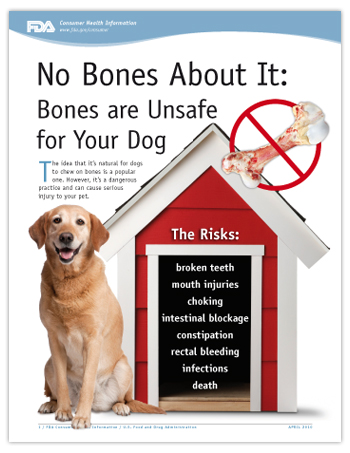No Bones About It: Bones are Unsafe for Your Dog

This article appears on FDA’s Consumer Updates page4, which features the latest on all FDA-regulated products.
The idea that it’s natural for dogs to chew on bones is a popular one. However, it’s a dangerous practice and can cause serious injury to your pet.
“Some people think it’s safe to give dogs large bones, like those from a ham or a roast,” says Carmela Stamper, D.V.M., a veterinarian in the Center for Veterinary Medicine at the Food and Drug Administration. “Bones are unsafe no matter what their size. Giving your dog a bone may make your pet a candidate for a trip to your veterinarian’s office later, possible emergency surgery, or even death.”
“Make sure you throw out bones from your own meals in a way that your dog can’t get to them,” adds Stamper, who suggests taking the trash out right away or putting the bones up high and out of your dog’s reach until you have a chance to dispose of them. “And pay attention to where your dog’s nose is when you walk him around the neighborhood—steer him away from any objects lying in the grass.”
Here are 10 reasons why it’s a bad idea to give your dog a bone:
- Broken teeth. This may call for expensive veterinary dentistry.
- Mouth or tongue injuries. These can be very bloody and messy and may require a trip to see your veterinarian.
- Bone gets looped around your dog’s lower jaw. This can be frightening or painful for your dog and potentially costly to you, as it usually means a trip to see your veterinarian.
- Bone gets stuck in esophagus, the tube that food travels through to reach the stomach. Your dog may gag, trying to bring the bone back up, and will need to see your veterinarian.
- Bone gets stuck in windpipe. This may happen if your dog accidentally inhales a small enough piece of bone. This is an emergency because your dog will have trouble breathing. Get your pet to your veterinarian immediately!
- Bone gets stuck in stomach. It went down just fine, but the bone may be too big to pass out of the stomach and into the intestines. Depending on the bone’s size, your dog may need surgery or upper gastrointestinal endoscopy, a procedure in which your veterinarian uses a long tube with a built-in camera and grabbing tools to try to remove the stuck bone from the stomach.
- Bone gets stuck in intestines and causes a blockage. It may be time for surgery.
- Constipation due to bone fragments. Your dog may have a hard time passing the bone fragments because they’re very sharp and they scrape the inside of the large intestine or rectum as they move along. This causes severe pain and may require a visit to your veterinarian.
- Severe bleeding from the rectum. This is very messy and can be dangerous. It’s time for a trip to see your veterinarian.
- Peritonitis. This nasty, difficult-to-treat bacterial infection of the abdomen is caused when bone fragments poke holes in your dog’s stomach or intestines. Your dog needs an emergency visit to your veterinarian because peritonitis can kill your dog.
“Talk with your veterinarian about alternatives to giving bones to your dog,” says Stamper. “There are many bone-like products made with materials that are safe for dogs to chew on.”
“Always supervise your dog with any chew product, especially one your dog hasn’t had before,” adds Stamper. “And always, if your dog ‘just isn’t acting right,’ call your veterinarian right away!”
- Behavior (12)
- Caring for your pet (266)
- cat (6)
- Community Events (19)
- dog (7)
- From Our Clients (15)
- Happy Tails (9)
- News (424)
- Press (53)
- Products (2)
- Questions (4)
- Recalls (1)
- Special Offers (5)
- Tips & Advice (231)
- Uncategorized (19)
- Veterinary Services (48)
